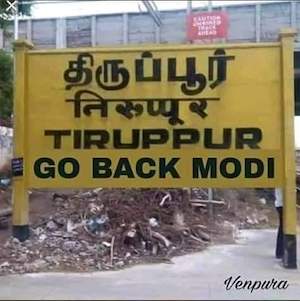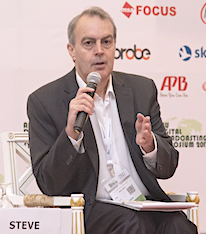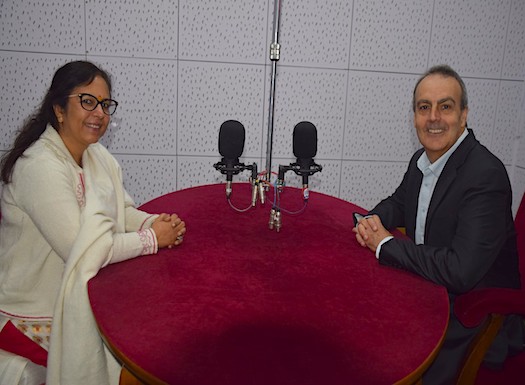This World Radio Day, Steve Ahern is in Delhi, India.
I am writing this year’s WRD letter just after being interviewed on All India Radio about the power of radio in the modern world.
In many interviews I do elsewhere about radio, people often ask me about radio dying. Nobody asked me about that here, because there is no sense that radio is dying in this country of over one billion people.
Radio is powerful here.
They didn’t ask about the death of radio, they asked about its future. That is the wonderful thing about India today, people are thinking of the future. There is a lot to be done in this country, its leaders recognize that, but they also recognize that looking backwards is not the way to get it done.
The questions I was asked in the two interviews I did were about how radio will meet the challenges of competitive media and why it is still powerful in the face of so much more media.
Of course there was acknowledgement of the golden days of radio, before television and new media, but it was in the context of learning what the strengths of the medium were, so that those strengths could be used to adapt to the future.
Those strengths include the intimate one-to-one nature of radio, the power to individualise pictures because every person paints a different picture in their heads, the adaptability of the audio medium, and the ability for audio to be delivered so easily on many platforms.
In this country the national broadcaster has been challenged over the past decade by the introduction of hundreds of new private broadcasters on the FM band, but instead of being defeated by the new competition, All India Radio is using it as an opportunity for evolution. Further challenges are now on the horizon from mobile social media. A broadcaster with tens of thousands of staff and the mandate to serve many sectors of society in multiple languages does not change quickly, but change is certainly happening inside AIR.
Last week I delivered a workshop to senior broadcasters and technical staff of the national broadcasters Doordashan (TV) and Akashvani Bhawan (All India Radio) which was about just that. We discussed the tools of new media and how they could be used to bring broadcasters into the new era, and we discovered the best ways to use those tools within the national broadcasting context.
One of the big issues here, and for broadcasters everywhere, is the tension between clicks and credibility. Should we chase audience at the expense of credibility, or should we maintain credibility even if our audience dwindles?
The answer is both.
Without an audience, you may as well not exist, because you will never fulfill your mandate if no one is listening or engaging with you.
Without credibility, you will not be able to fulfill your mission to inform the public, and in this country there is a great need for accurate news and information.
There is a national election looming here in India and fake news and media manipulation seem to be very much a part of it.
Credible broadcasters such as AIR and Doordashan want to play a role in debuking hoaxes, it is part of their new way to respond to their charter obligations. However they won’t be able to do that unless they are delivering their content and engaging on new social media platforms as well as on their broadcast airwaves. Nor will they be able to do that if they are too slow to respond to trending topics as they happen. Both these issues are currently being addressed by the national broadcaster.
Broadcasters like AIR have spent decades building the skills inside their organizations to report news carefully and accurately. They now want to deploy those skills to analyze and call out fake news, which will benefit the whole of society, especially at election time.
Savvy established broadcasters all around the world are working with governments to try to curb the worst excesses of new media platforms by using the long established skills of credible media in conjunction with new regulations (such as declaring the source of facebook party-political advertising ) to try and balance the need to preserve the principle of free speech with the ability to identify hoaxes and manipulation.
In one of the interviews I was asked about the influence of radio, quoting examples from literature, such as Agatha Christie and Anne Frank, where radio was noted as having such an important role in society.
In answer I explained that these nostalgic examples give us a warm feeling of the importance of radio, but I then examined them in a forensic way to try and understand why radio was so influential in the era before television and social media. Back then there were two reasons why radio was influential – the content on the radio and the magic of the radio medium itself.
Back when radio was new, people didn’t understand the technology and though it was somehow magical, a ‘magic box’ that carried disembodied voices to your living room. This led to a belief that everything on the radio was automatically credible. We have come a long way since then, we now know about the technology behind the medium and understand that radio waves are just a carrier for the more important element of radio… the content.
In this modern era, and in this country, the new ‘magic box’ is the smart phone. People tend to believe what they hear, see and share on it without much scrutiny. This is not just a phenomenon in India, it is worldwide.
The always-connected smartphone era is still young here and education about it is only just beginning to develop sophistication amongst consumers. Meanwhile hoaxes and scams run rampant and fake news spreads like wildfire. Broadcasters here (and everywhere) have a role to play in educating the population about scams on new media – this is being done by weaving stories of scammers into popular dramas and making public service announcements about hoaxes and scams.
 Just this week there are many examples of badly doctored photos (right) being spread as part of an anti-government social media campaign tagged #GoBackModi. I readily found many badly photoshopped examples of fake photos in social media posts linked to this campaign.
Just this week there are many examples of badly doctored photos (right) being spread as part of an anti-government social media campaign tagged #GoBackModi. I readily found many badly photoshopped examples of fake photos in social media posts linked to this campaign.
I know there is some opposition to Prime Minister Modi’s 5 years in power, but I don’t know enough about Indian politics to know if this is widespread or if it is just being artificially amplified via social media. I guess we will find out when India goes to the polls later this year.
Journalists and broadcasters at All India Radio are using the established skills of credible journalism to fight fake news: source checking, investigation, confirmation, attribution, systematic questioning and accurate quotation. They need to be able to rapidly deploy these weapons on the social media battlefield to counteract the impact of this phenomenon.
Good content cannot be limited to the airwaves alone any more.
Credible broadcasters who are doing good work must push out their content on social media platforms just as efficiently and quickly as they do on air, and just as quickly as the fake news purveyors do. Otherwise the skills that have been built up in credible radio organizations will not serve the greater good of society, as they are mandated to do. Not just here in India, but everywhere.
Radio has the power to promote dialogue, tolerance and peace, the theme of this year’s World Radio Day, but only if we take radio in its broadest context and ensure that the audio content we are creating (whether news, entertainment, drama, etc) evolves to be able to reach everyone who needs it, on whatever platform they are consuming it on.
Happy World Radio Day!
Read Steve’s previous World Radio Day letters:
About the Author
 Steve Ahern is a former commercial, community and public service broadcaster, programmer, senior executive and trainer who now runs his own company Ahern Media & Training Pty Ltd.
Steve Ahern is a former commercial, community and public service broadcaster, programmer, senior executive and trainer who now runs his own company Ahern Media & Training Pty Ltd.
He was previously Director of Radio at the Australian Film Television and Radio School and is currently a board member of Australia’s Community Broadcasting Foundation. He also sits on the boards of various media services companies in Australian and internationally.
Steve is the founding editor of this website.

